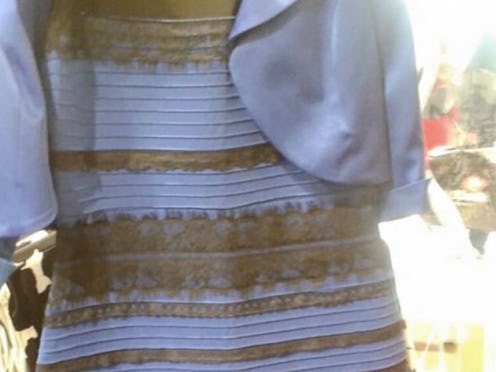Life
Science Is Trying To Explain The Dress

Do you remember The Dress? Ah, how could you forget it? Well now, there's an official, peer-reviewed brain scan study on The Dress, and it helps to explain our divide between seeing blue and black and white and gold. When the striped wonder came onto the Internet, it quickly divided opinions, but much of the commentary on what was happening was unfortunately a bit speculative. Thanks to science, The Dress has become the subject of a proper study, and contributes to our modern body of scientific knowledge.
Neurologists from two universities in Germany (BG University Hospital Bergmannsheil and Ruhr University Bochum) and led by Lara Schlaffke teamed up to begin to understand the physical basis of this odd sensory perception provided by The Dress. They used functional magnetic resonance imaging (fMRI) to view the brains of 28 experimental participants while viewing the dress (14 who saw it as black and blue, and 14 who saw it as white and gold). The hope was that the activity shown in the brains of the two groups would be somehow different, offering a clue as to what was going on to generate the difference of opinion.
There was indeed a difference in the brain scans of the two groups of dress viewers. As published in the journal Cortex, "the people who see the dress as white and gold showed extra activation in a raft of brain areas, including in frontal, parietal (near the crown of the head) and temporal (near the ears) regions." These regions of the brain are involved in active interpretation of visual stimuli, so basically the scans suggest that white and gold dress viewers' brains were doing more active processing of the dress image to arrive at their opinion.
It's normal for our brains to do some active processing of visual stimuli. For instance, an ability known as "color constancy" means that humans understand that some objects maintain their same colors even when viewed in different levels of ambient lighting. The software in our minds does this automatically; we don't have to choose to adjust for lighting conditions when we see stuff. But this same automaticity means that there are a few edge cases, like The Dress, where people's brains are drawing different conclusions as to its "real" color, and feeling absolutely sure of their own opinion because it was generated so naturally. Interestingly, the participants did not disagree on the colors when shown modified images of The Dress where the lighting around it was less weird. So something about this judgment mechanism is what's causing our disagreements.
If you combine these findings with pre-existing results about surveys on The Dress, it actually has interesting implications. Dress viewers were pretty evenly divided between team black and blue and team white and gold across several demographic categories, including gender, location, and iPhone/Android. Though it's too little data to draw broad conclusions, the new study might suggest, for instance, that there is no broad gender difference in active versus passive color processing, because otherwise The Dress viewers would have split less evenly along gender lines. Hopefully more future research can examine these and other possibilities.
Image: Giphy